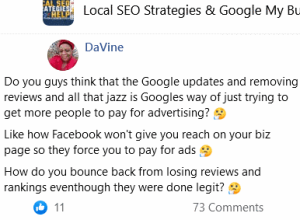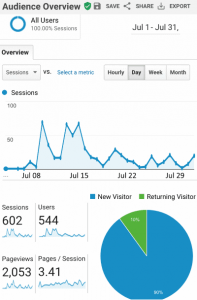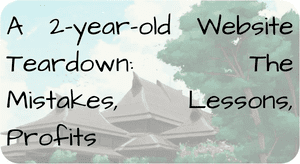CASE STUDY: Transitioning my niche site to ecommerce using Shopify Disclaimer: My site is very small and I don't purport this to be a gamechanger for, well, anyone. I just wanted to share something that is seeming to work well for me.
I started my niche site in < year > — it is focused around a particular type of vehicle that has a hobbyist following. Initially the site was monetized through a combination of Google Adsense and the Amazon Associates program. At some point, I started trying to diversify the income as much as possible. For me, this meant adding the eBay Partner Network for some items and applying for Ezoic as soon as I met the requirements.
I also experimented with some small affiliate programs but didn't have much success — I had to get very creative to find them as most of the stores I really wanted to refer sales for did not offer an affiliate program. I reached out to them multiple times seeing if there was something we could arrange. I even offered to just sell display ads to them, but no dice. The result was signing up for a couple small affiliate programs with low commissions and low sales volume proructs. This frustration was the start of my desire to curate my own store of products I genuinely want to sell.
Shopify and subdomaining
I use Shopify to host my online store. I am a software engineer by profession so I generally don't consider ease-of-use and setup to be the most important factors when choosing software — I just want whatever is the most effective. There are other options like WooCommerce that I have heard great things about.
However, for me, Shopify is almost magically easy to use and offers everything I have needed or wanted so far. Following Warren Buffet's advice to "buy what you like" I actually bought as much stock in the company as I could after using it for a month. Everything just works exactly how I expect it to. I have never struggled to find any answers or documentation about anything. The support is phenomenal.
It's just a great product — to me I think they could be a bigger company then Amazon in a few years because it allows anyone to create to sell online and maintain a lot of control, something retailers lose with Amazon. I signed up for the Shopify affiliate program because I want to refer people to it, not to refer people to it. I helped my cousin set one up for his beef jerky business and it took 20 minutes before he was online and it has been a gamechanger. The small independent grocery store across the street from me is surviving (probably thriving) through c0v1d-19 because they allow online orders through Shopify and window pickup. But most importantly, it's great to get the little notification when you make a sale, especially when the margins are so much higher than affiliate, but I'll get to that later.
For me, I used a shop.mydomain.com subdomain for my Shopify site. It's great because there are no conflicts with your WordPress site and it's a very clean looking link. Shopify has some documentation https://help.Shopify.com/en/manual/domains/add-a-domain/using-existing-domains/connecting-domains#connect-a-subdomain on this if you would like to try it.
Profit Margins
Selling items yourself is great mainly because you get to choose and experiment with your profit margins. Want to experiment with razor-thin margins because you know your visitors will shop around a lot? Try it. Want to raise the price so any one sale is $80 in profit but you don't have to pack and ship as much? Might work, try it! Between Google Analytics and Shopify's analytics stats, you can measure anything you need to.
Here's a concrete example of one item from my site. I sell a particular type of spark plug that is used on a vehicle that my site is partly focused on. This is an item I have sold/referred in one way or another since the beginning of my site in < year >:
• Amazon Associates commission: $0.84 (before commission slashing!)
• Average Amazon Associates sales/month: 3
• Shopify profit margin: $14.06
• Average sales/month: 4
This is a small item that is extremely easy to buy in bulk and pack/ship quickly.
I actually averaged more clicks to this item when the destination was Amazon, so my conversion rate actually went up when I moved away from Amazon. I charge a few dollars more than Amazon and many other online retailers for this item. I could probably do some experimenting to find the optimal price/sales ratio, but I think those numbers speak for themselves.
One of my early fears was that the trust people have for Amazon and their affinity towards Prime is hard to challenge, but my opinion is that the trust you gain by writing well-researched, meaningful articles and being an active participant in the niche you serve makes people want to support you.
Dropshipping
Dropshipping has negative connotations because of the bastardized "buy cheap small items from overseas and make 4000% profit while the user doesn't know that the item wont arrive for 2 months" format that is shown by YouTube influencers and the like. However, dropshipping is simply collecting a sale yourself while having an underlying price agreement with a supplier who will pack and ship the item for you. The first item I sold through my Shopify store I actually sold on a dropshipping basis.
This was a line of products within the $200-300 price range, and I also sold these through the Amazon Associates program before. It was nice to make $10-17 for one sale, but I felt like I should be making more. I called the company that produces this item and asked to buy 3 or 4 to sell myself, but he suggested dropshipping instead which I was interested in as these items are rather large. I agreed to buy the items for around $160-200 and now I profit around $60 per sale — the only effort required on my end is sending an email (gave them a card to have on file) and adding the tracking number to Shopify when it is available. The credit card points are nice too!
One other thing about this that I think is important — It's really nice to have personal relationships that this kind of business offers. The guy that answered the phone was the owner of the small business and he's the nicest guy, great to deal with and it feels good to get him some sales, especially during a crisis like this. I actually met up with him at an industry event and we talked for a long time. He's an older guy and at some point I want to get him setup with a better online presence especially as he sells a lot of other products over the phone that I can't necessarily refer in my niche, but could definitely benefit from a real online store and web presence. I am building similar relationships with other suppliers and personally I love it.
Item Selection
If you go the route of stocking and shipping items yourself, the scope of products you can monetize through your site broadens drastically. For me, there was always a certain type of item that I wanted to sell, but I could never find a good version of this item on Amazon or anywhere that offered an affiliate program. This was actually one of the retailers I reached out to asking for an affiliate program to no avail. Then I asked for a dropshipping agreement — the answer was still no. However, it's a lot easier when you ask to buy 50x of one item. They processed my distributor account in a day and had my items to me by the end of the week. It is now my best selling item!
Shipping Logistics and Tools
One of the things that I think could be a dealbreaker for people is something I personally really enjoy — stocking, packing, and shipping items. My inventory is small enough to fit in a walk-in closet in my apartment. I love the process of getting the Shopfiy "ca-ching" notification, packing the order, and dropping it off at the mailbox. Here are some tools I have used to make this process more efficient:
• Label printer: I initially bought the cheapest option on Amazon. This was a mistake. That thing was absolute garbage. Then I bought a Brother QL-1100 and I love it. It's nearly $200 but worth every penny. The driver worked immediately, a stark contrast to the earlier printer. Prints quickly in very high quality. You can get away with using a regular printer, cutting out the label, and taping it on your package, but the presentation value is much better with a good label printer.
• Standard printer: Use for leaving a packing slip, order receipt, etc.
• Computer: Definitely not important, but I like to have a dedicated laptop for my "ship station" right next to my label printer and regular printer.
Here is part of my dedicated "ship-station" where I manage my store and print labels/packing slips.
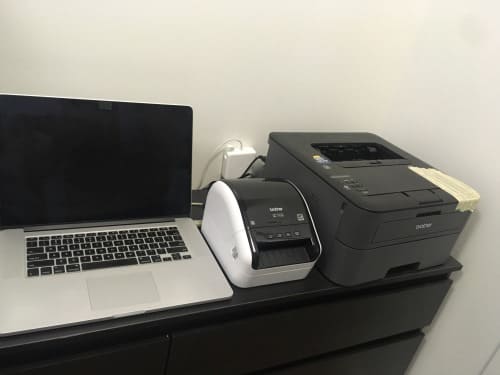
I would probably wait to receive the items you're selling before selecting the packaging you're going to use. That way you can take exact measurements and consider alternative sizes/types of packages. One of my items is a collection of smaller items. I throw away the box that my supplier ships it in, and put it in a bag that goes inside my small mailer box. I use a particular size of bubble wrap which was also specifically chosen to protect the item, while also taking up all of the surrounding space. It's much easier to make all of these choices when you have the item in front of you.
Here's the previously mentioned item (spark plugs) in the box I chose (bubble wrap not shown!) There is no wasted space when it is packed.
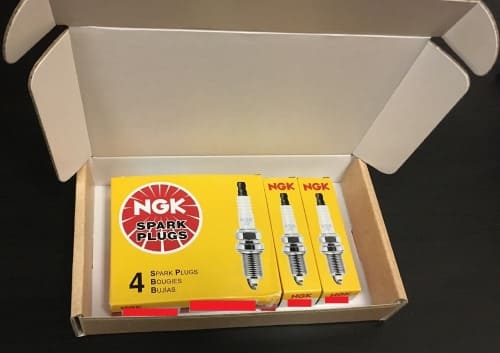
For me, I use USPS for nearly all of my orders. It's usually the cheapest option and very fast for the size of item I have. I live in an apartment complex and I can just drop my packages in the mailroom and they get picked up daily. Shopify will show you all of the available shipping options with speed and price. For international orders, it's only a few dollars more, and I think it goes from USPS and gets picked up by DHL.
Item Presentation
Another benefit of this approach is that you have infinitely more opportunity to make a good impression on your customers which is huge if your items are the kind that might be reordered, or if the customer may be interested in other items you sell. For me, item presentation is also important because as I said, I am operating out of a spare closet in my apartment, so I want to look as professional as possible.
Here are some ways you can do this:
• Light box: You definitely don't want to just pick pictures from Google Images. Take your own pictures. I bought a decent sized light box from Amazon for around $70 and it makes a massive difference. I would link it here but it seems like it's no longer available. I have an iPhone SE which is worlds away from most good cameras these days, but with the light box my pictures look extremely professional. This is not an item I sell (it's my beard comb) but I did a quick comparisonof using the light box vs. my initial approach: using printer paper with an overhead lamp.

• Custom packaging: As discussed before, get your measurements and then choose the package you want to ship in. For me, I wanted to have some custom packaging with my logo on it. I didn't buy in huge bulk so it cost me about $3 per mailer box for the first order of packaging. It's a lot when my margins are mostly $20-40, but to me it is important. For companies to consider, I strongly recommend UPrinting or Packwire.
• EDIT: I originally noted issues I had with Packwire here but Phil from Packwire spotted it and he is sending me a new shipment free of charge that we expect will solve the issue I had. Thank you Phil! Based on this experience alone I would recommend trying them out if you need custom packages.
• Packing slips/notes: All of my orders contain a thank you note to the customer with my name and email. I thank them for the order and ask them to reach out if they have any questions or concerns. I also ask them to reach out if there's any item they would be interested in that they do not currently see on my store. I haven't had any responses recommending products customers would be interested in, but I did have one customer ask about using the item. I sent him my number and he gave me a call and I explained everything to him. I think my store will be his first stop if he ever needs anything else.
• Dual use of label printer: Use your label printer to look more professional. On the item that I put into a bag and then into my mailer box, I have item label stickers that I put on the bag. It has my logo and the item title and ID number of the item within my store. It is a nice added touch and I think it looks very official.
Advertising
I have not yet started experimenting with any form of ads. All of my sales thus far have been the result of organic traffic from the content on my website funneled through to my store. This month I am going to experiment with Facebook and Google Ads. Obviously this may not work but if there is a decent enough margin after the increased customer acquisition cost I will continue. I will report these results later!
Legality and Relationship to Affiliate Marketing
Keeping in mind that we in this business typically operate as affiliates, the golden rule is to make sure you are recommending the absolute best products to your site visitors. Thinking back to the Casper mattress affiliate drama, there should be research and thought behind your recommendations. Selling the items yourself does complicate this. I have used all of the items I sell on my store. When I moved my links over from Amazon, I kept the notes indicating that I have used the item, but I also added a link to an explanation of my store.
I think it ends up being an extra vote of confidence when I explain to users: I have tried the items I sell and think they are the best in their category. I used to sell these items as an affiliate and would receive a commission, but I believe in them strongly enough that I now stock and sell them myself. I am not the only one who sells them and you can certainly buy from others if you find a better price/shipping speed.
I'll restate what I said before because I think it is extremely illuminating: My conversion rates went up when I moved items from Amazon to my own store!
The bottom line is that you need to be explicit about these things to be safe and honest. I think my niche works particularly well for this as people are looking for a.) What exact version of the item do I need? and b.) How do I use it? I know many niche sites are focused around "Top 10 X" type content and this may become a lot more difficult within the honesty/legality context. Something to think about.
As a final note, I still operate this as a sole proprietorship. Eventually I want to get an Limited Liability Company (LLC) for it. I have been upfront about this with all of my suppliers and none of them have required this for a distributor agreement.
My Stats
Here are my income sources over time. I apologize for the colors used in the line charts of individual sources, I could not figure out how to configure those.
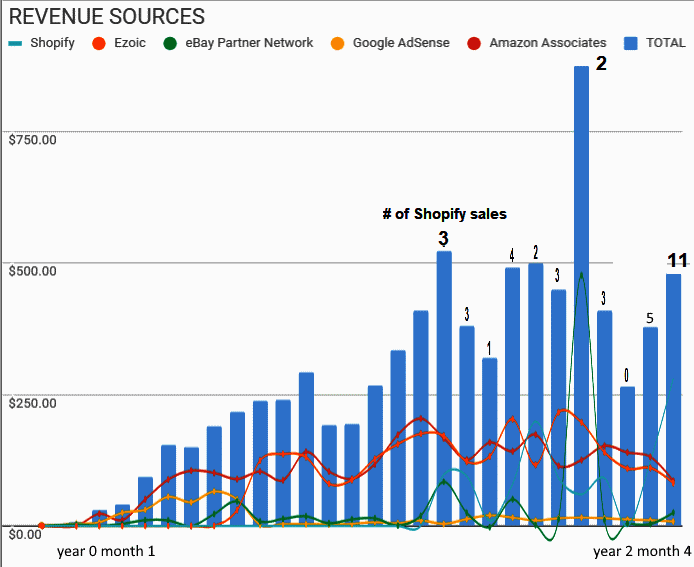

As you can see, my site is very small. However, the relationship between the decline these past few months in display advertising revenue (Ezoic literally sent an email saying to expect lower rates) and the Amazon Associates rate cut charted against my growing Shopify revenue really opened my eyes to the benefit I gained from diversifying towards ecommerce/Shopify. I still keep the older sources of revenue, but I actually think I will consider eliminating them in the future, especially display ads. Diversification is necessary when the revenue source lacks control — Amazon Associates can slash rates willy-nilly, eBay Partner Network can apparently just decide to not pay me for a large sale I made, who even knows what these display ad networks are actually getting paid for our clicks or if every click is considered, etc.
Selling the items yourself gives you a lot more responsibility, but a lot more control. One of the primary reasons I'm so excited about this is that my inventory is still VERY small. I am working to add new items and it's wonderful because even if I only sell a few, the profit margins make it so much easier to spend the time to create the content and stock/ship the item — a luxury I never had with Amazon.
To Write Articles or Publish Content Fast
Demand Gen Strategy on LinkedIn
$450k Income From Copywriting for Clients
60 Top Tools for Content Marketing
